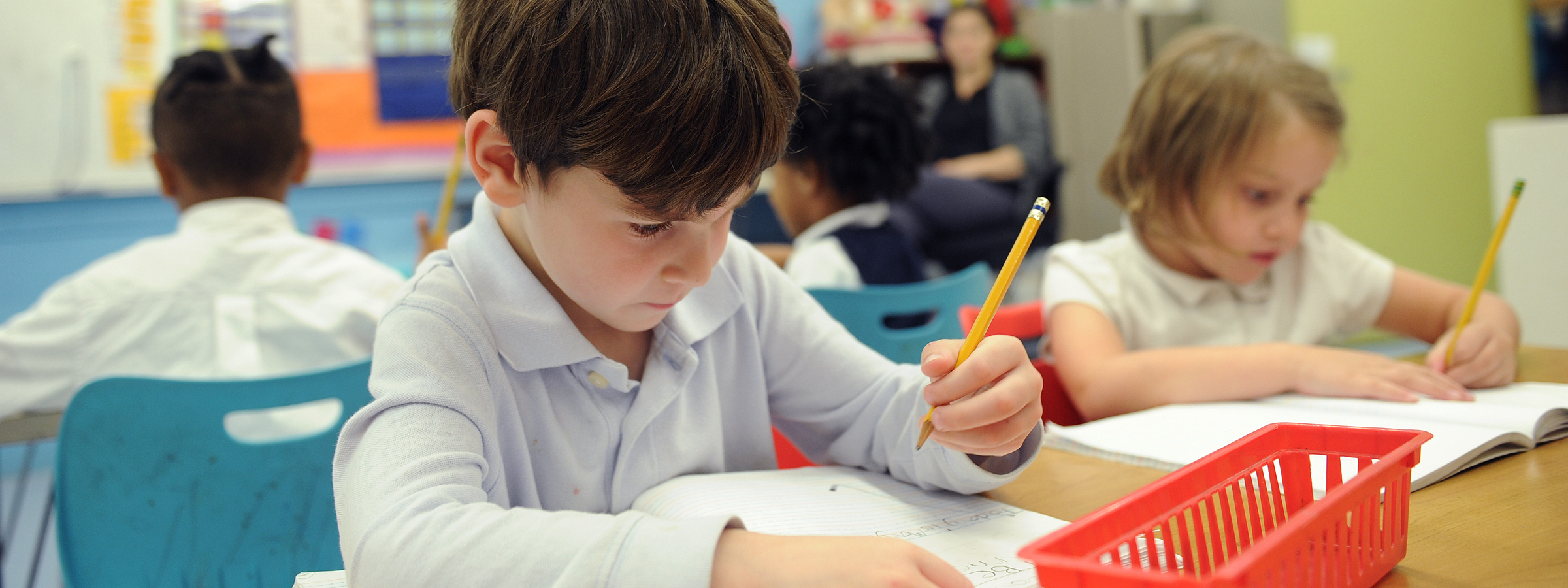Program


Mathematics instruction is based on research-based best practice programs, and is scheduled to allow for flexible response to individual students’ needs and challenges. Students use Eureka Math in whole-class instruction for 60 minutes daily. Students get additional time every day to work in math stations to practice the skills their MAP scores indicate need strengthening. This is done through intervention in small groups, and through independent practice (via Compass Learning or with pencil-and-paper work).
Teachers plan on-grade-level Eureka lessons, and accompany these plans with small group and individual plans designed to reach and teach each student where they are.
English Language Arts (ELA) instruction is rooted in two sources: carefully chosen, research-based instructional Language Arts programs like Core Knowledge, Wilson Fundations, and ThinkCERCA, and each student’s own learning needs. All students take the NWEA MAP, and while every student spends time every day working in whole-class Language Arts programs, they also get time to work through a customized Language Arts instructional program, based on their MAP performance, and developed and revised regularly by their teacher.
In grades K-2, the two main ELA instructional programs are Wilson Fundations for phonics and word study, and Core Knowledge’s Listening and Learning strand of sequenced units/learning modules. In their daily 2+ hours of ELA instruction, K-2 students use Fundations for systematic phonics, spelling, and handwriting instruction, and Core Knowledge’s Listening and Learning program, built around a series of sequenced read-alouds, designed to help students build the background knowledge and vocabulary critical to listening and reading comprehension. During their 2+ hour ELA block, K-2 students also spend time in reading rotations, where they work in Guided Reading groups (including Fountas and Pinell’s Leveled Literacy Intervention), use Compass Learning for extensions and intervention, and do independent reading. They also work daily on handwriting and, 2nd graders begin typing practice.
Our Science program is built around Houghton Mifflin Harcourt’s Science Dimensions curriculum. The course of study is integrated science, which will provide the foundation for later studies in engineering and design, life sciences, physics, and Earth and space science. Engineering design is integrated into all scientific disciplines, as is critical thinking and extensions to STEM-based careers. Reading, writing, and vocabulary strategies are also embedded in all daily work.
Every lesson includes a hands-on activity and is organized so that students drive the learning: they start by engaging with a question or discrepant phenomenon, exploring evidence, and then attempt to explain their claims, elaborate on and apply new understandings to the real world, and evaluate their learning throughout. This “5 E” instructional approach lies at the core of Dimensions instruction in all grades.
We are strong believers in personalized learning – ensuring that each and every child has the opportunity to grow academically and socially in ways that are tailored to their needs and learning styles. Our personalized approach to learning is enhanced by our small student to teacher ratios – transforming the classroom experience into one of a genuine community which in turn promotes positive emotional development in each child.
Our school is part of a growing movement of linguistically diverse public charter schools, teaching languages as varied as Modern Hebrew, Greek, Mandarin, French, and Arabic. This movement is based in part on a wide body of research showing the many benefits of learning a foreign language:
At PHP, Modern Hebrew is taught through the proficiency-based approach, which is considered the gold standard in foreign language instruction in the United States and around the world. Students receive one hour of Hebrew language instruction four days per week. They engage in meaningful interactions in the language, developing their speaking and comprehension skills at a rapid pace. As students advance through the grade levels, speaking and listening skills continue to be developed and reading and writing are introduced, developed and strengthened.
Modern Hebrew is taught by native speakers, who only speak to their students in Hebrew. In just a short time, students are able to understand Hebrew and speak in simple sentences. As their skills grow, they are introduced to more complex topics and are able to communicate in Hebrew in more sophisticated ways. As students learn Modern Hebrew, they also have the opportunity to learn about the culture and history of Israel, which provides a link to other subjects such as social studies and the arts.
Want to learn more? Check out the Hebrew Public website.